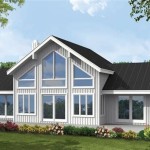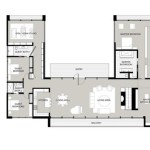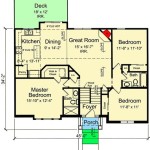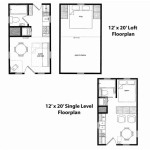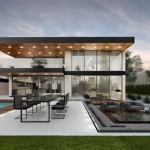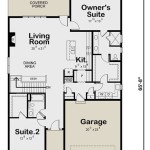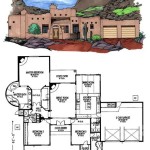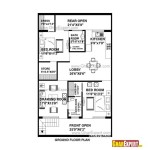Open Floor Plan Pole Barn Homes: A Comprehensive Guide
Pole barn homes, also known as post-frame homes, represent a versatile and increasingly popular alternative to traditional stick-built houses. The inherent design of pole barn construction lends itself exceptionally well to open floor plans, creating spacious and customizable living environments. This article explores the characteristics of open floor plan pole barn homes, detailing their benefits, considerations, and the process involved in their construction.
Pole barn construction utilizes large, solid posts embedded in the ground or attached to a concrete foundation as the primary structural support. These posts are spaced at regular intervals and connected by horizontal beams. This framework provides exceptional strength and allows for large, unobstructed interior spaces. The absence of load-bearing interior walls is the key factor that facilitates the creation of open floor plans. The exterior walls primarily serve as enclosure, rather than bearing structural weight.
The Appeal of Open Floor Plans in Pole Barn Homes
Open floor plans are characterized by the minimal use of interior walls to separate living spaces. Typically, the kitchen, dining area, and living room flow seamlessly into one another, creating a large, communal area. This design philosophy offers numerous advantages, particularly within the context of a pole barn home.
One of the primary benefits is enhanced natural light. Without interior walls obstructing the flow, sunlight can penetrate deeper into the home, creating a brighter and more inviting atmosphere. This reduces the reliance on artificial lighting, potentially lowering energy consumption and creating a more comfortable living environment. Furthermore, open floor plans facilitate better ventilation, allowing air to circulate freely throughout the home.
The spaciousness of an open floor plan contributes to a feeling of freedom and flexibility. Homeowners can easily reconfigure the layout to suit their changing needs. Furniture can be rearranged to create different zones within the open space, and the absence of fixed walls allows for greater creativity in interior design. This adaptability makes open floor plan pole barn homes ideal for families, individuals who enjoy entertaining, or those who simply appreciate a sense of openness and airiness in their living space.
From a social perspective, open floor plans encourage interaction and communication among occupants. Family members can be in different areas of the home while still maintaining visual and auditory contact. This is particularly beneficial for families with young children, allowing parents to supervise their activities while preparing meals or relaxing in the living room. Similarly, when entertaining guests, an open floor plan facilitates mingling and conversation, creating a more welcoming and engaging social atmosphere.
Key Considerations for Designing an Open Floor Plan Pole Barn Home
While open floor plans offer numerous advantages, careful planning and design are essential to ensure functionality and comfort. Several factors must be considered to create a successful open living space within a pole barn home.
Acoustics are a crucial consideration in open floor plans. The absence of walls can lead to sound reverberation and a lack of privacy. Implementing sound-dampening materials, such as rugs, curtains, and upholstered furniture, can help to mitigate noise levels and create a more comfortable acoustic environment. Strategically placed area rugs can define specific zones within the open space while also absorbing sound. The use of acoustic panels on walls or ceilings can further reduce noise transmission.
Zoning is also important for creating distinct functional areas within the open space. While walls are absent, it is still necessary to delineate the kitchen, dining area, and living room. This can be achieved through the use of furniture placement, changes in flooring materials, and variations in lighting. For example, a kitchen island can serve as a visual barrier between the kitchen and the living room, while a different type of flooring can distinguish the dining area from the rest of the space. Purposeful furniture arrangement defines usable zones. Lighting can contribute to defining zones, with brighter task lighting in the kitchen and softer, more ambient lighting in the living room.
Heating and cooling can present challenges in open floor plans. The large, unpartitioned space can require higher heating and cooling capacity to maintain a consistent temperature throughout the home. Proper insulation is essential to minimize energy loss and ensure comfortable indoor temperatures. Consider using a zoned heating and cooling system to control the temperature in different areas of the home. This allows for more efficient energy use and greater comfort for occupants. Radiant floor heating is another option that can provide even and efficient heating throughout the open space.
Privacy should also be addressed when designing an open floor plan. While the main living areas are open and communal, it is important to provide privacy in bedrooms and bathrooms. These spaces should be enclosed with walls and doors to create private retreats within the larger open living space. Careful planning of the layout can also create a sense of privacy in certain areas of the open space, such as a reading nook or a home office.
The Process of Building an Open Floor Plan Pole Barn Home
Constructing an open floor plan pole barn home involves a series of steps, from initial planning and design to final finishing and landscaping. Understanding the process can help homeowners make informed decisions and ensure a successful outcome.
The initial phase involves planning and design. This includes determining the size and layout of the home, as well as selecting the materials and finishes. Work with an experienced architect or designer who understands pole barn construction and open floor plan design. They can help to optimize the layout for functionality, aesthetics, and energy efficiency. Obtain necessary permits and ensure compliance with local building codes.
Next comes the foundation and framing. The foundation can be either a concrete slab or a pier foundation, depending on the soil conditions and the homeowner's preferences. The posts are then set in the ground or attached to the foundation. These posts form the structural framework of the home. The horizontal beams are then installed to connect the posts and provide additional support. The framing must be precise and accurately aligned to ensure the structural integrity of the home.
Once the framing is complete, the exterior walls and roof are installed. The exterior walls can be made of a variety of materials, such as metal siding, wood siding, or stucco. The roof can be metal, asphalt shingles, or another roofing material. Proper insulation is crucial at this stage to minimize energy loss and ensure comfortable indoor temperatures. High-quality insulation in the walls and roof will contribute to lower energy bills and a more comfortable living environment.
The interior finishing phase involves installing the electrical, plumbing, and HVAC systems. This also includes framing interior walls for bedrooms and bathrooms, installing drywall, and applying paint or wallpaper. Cabinetry, flooring, and fixtures are also installed during this phase. Careful attention to detail is essential to create a high-quality and aesthetically pleasing interior. Focus on quality materials and craftsmanship to ensure the longevity and durability of the finishes.
Finally, the landscaping and exterior finishes are completed. This includes grading the land, installing walkways and driveways, and planting trees and shrubs. The exterior finishes can include siding, trim, and paint. The landscaping should complement the design of the home and create an inviting outdoor living space. A well-designed landscape can enhance the curb appeal of the home and create a welcoming environment for residents and visitors.
Open floor plan pole barn homes offer a unique and versatile living experience. By carefully considering the design challenges and implementing appropriate solutions, homeowners can create a spacious, comfortable, and aesthetically pleasing living environment that meets their individual needs and preferences. The inherent strength and flexibility of pole barn construction, combined with the open and airy feel of an open floor plan, makes this a compelling option for those seeking a modern and customizable home.
Cost Considerations for Open Floor Plan Pole Barn Homes
The cost of building an open floor plan pole barn home can vary significantly depending on several factors, including the size and complexity of the design, the materials used, and the location of the project. However, pole barn construction is often more cost-effective than traditional stick-built construction. This is due to the simplified framing process and the reduced need for load-bearing interior walls.
Several specific cost factors need to be considered during the budgeting phase. The size of the structure is the most impactful cost factor, with larger homes obviously requiring more materials and labor. The choice of materials also has a major impact. Using premium siding, roofing, and flooring materials will increase the overall cost. The complexity of the design affects costs, with more elaborate designs requiring more intricate framing and detailing. Site preparation costs can add to the expenses, particularly if the site requires extensive grading or excavation. Labor costs also need to be factored, considering that labor rates vary by region.
To mitigate potential cost overruns, creating a detailed budget before construction begins is essential. Obtain multiple quotes from contractors to compare prices and services. Consider using cost-effective materials without sacrificing quality. Prioritize essential features and avoid unnecessary upgrades. Plan for contingencies to cover unexpected expenses. Communication with the contractor throughout the construction process is another crucial aspect. Regular communication can help to identify and address potential cost increases early on.
Open Concept Barn House Plans Blog Dreamhomesource Com

Open Concept Barn House Plans Blog Dreamhomesource Com

Barn House Designs With Open Floor Plans Houseplans Blog Com

Open Concept Kitchen

Building A Pole Barn Home In Colorado

40x60 Pole Barn House Plans

Pole Barn Home Vs Barndominium Which Is The Better

Open Concept Barn House Plans Blog Dreamhomesource Com

Bwood Barn Barndominium Modern House Open Plan Design 100 X 36 4 Bed 3 Bath Drawings Blueprints

Barndominium And Farmhouse Duplex Plans Houseplans Blog Com

